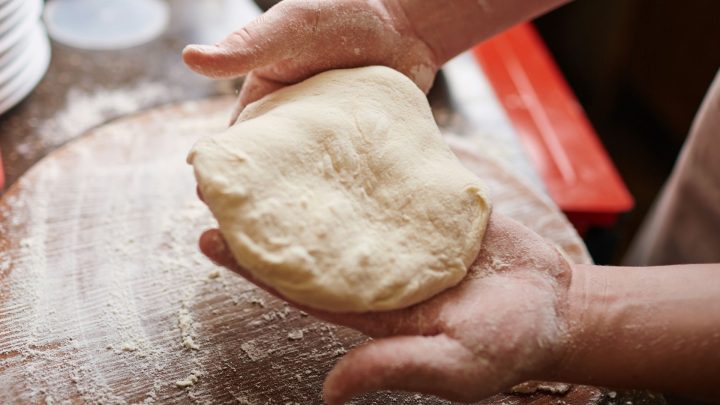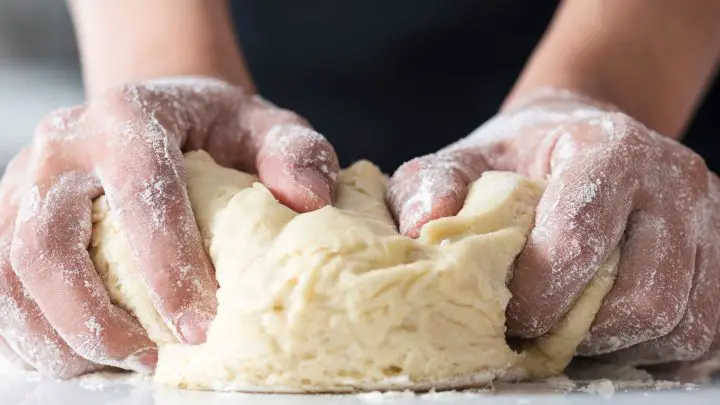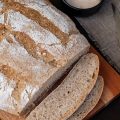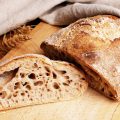Dealing with flat sourdough bread can be frustrating, but there are steps you can take to troubleshoot and improve your results. By identifying the underlying causes and making necessary adjustments, you can achieve the desired rise and structure in your loaves. From examining the fermentation process to evaluating proofing times, flour choices, handling techniques, and baking methods, this troubleshooting guide will provide you with insights and practical tips to overcome the challenges of flat sourdough bread. You’ll be on your way to creating beautifully risen and delicious sourdough loaves!

Table of Contents
- What Does It Mean If My Sourdough is Flat?
- Common Reasons For Flat Sourdough Bread
- Ways of Troubleshooting Flat Sourdough Breads
- What Should I Do With Flat Bread?
- Flat Sourdough – You Can Do Something About It!
- FAQs
What Does It Mean If My Sourdough is Flat?
When making sourdough bread, if you notice your sourdough is flat, it means that the dough did not rise adequately during the fermentation and baking process.
This could be due to several factors, including:
- insufficient yeast activity
- underproofing
- weak gluten development
- improper shaping
Identifying the specific issue and adjusting factors can help achieve a better rise and avoid flat sourdough loaves during sourdough baking. These factors are:
- fermentation time
- yeast strength
- proofing conditions
- shaping techniques
Common Reasons For Flat Sourdough Bread
Flat sourdough bread can be frustrating, but understanding the common reasons behind it can help you troubleshoot and achieve better results.
Factors like weak or exhausted sourdough starters, under or overproofed dough, flour issues, and problems in the baking process can contribute to flat loaves. Addressing these issues can lead to beautifully risen sourdough bread.
Flour Issues
Flour issues can often lead to flat sourdough bread due to various factors.
Using low-gluten bread flour or incorporating a high percentage of rye flour or whole wheat can result in weaker gluten development. This reduces the bread’s ability to rise adequately. Insufficient gluten formation leads to a lack of structure and compromised oven springs.
Using a balanced blend of flour with appropriate protein content, and ensuring good gluten development is crucial for achieving optimal oven spring. This helps avoid flat sourdough bread.
Exhausted or Weak Sourdough Starter
An exhausted or weak sourdough starter is a common issue for flat sourdough bread. This is because the starter plays a crucial role in fermentation and leavening.
If the starter is not vibrant and active, it may lack sufficient yeast and bacteria to produce the necessary carbon dioxide gas for proper rise. This can result in a limited oven spring and a flat loaf.
Regularly feeding and maintaining the starter, ensuring it is active and healthy, and adjusting fermentation times accordingly can help prevent flat sourdough bread caused by a weak or exhausted starter.
Under or Over Proofed Dough
During a bread-making process, an underproofed or over-proofed dough can lead to flat sourdough bread. If the dough of your sourdough is underproofed, it hasn’t had enough time for the yeast to generate sufficient carbon dioxide, resulting in a limited rise during baking.
On the other hand, an over-proofed dough means the yeast has consumed most of the available sugars. This causes weakened gluten structure and gas retention. This then leads to a collapse during baking and a flat end result.
Properly monitoring fermentation times, adjusting based on environmental factors, and understanding the signs of optimal proofing can help avoid flat sourdough bread.
Your Baking Process
The baking process itself can contribute to flat sourdough bread if certain aspects are not properly addressed.
For example, if the oven temperature is too low, the bread may not receive sufficient heat to create proper oven spring, resulting in a flat loaf. Inadequate preheating of the oven or using a baking vessel that doesn’t retain enough heat can also affect the rise. Additionally, opening the oven door too frequently during baking can cause temperature fluctuations and hinder proper rise.
Ensure proper oven preheating, maintain consistent temperature, and minimize disruptions during baking. All these can help prevent flat sourdough bread.
Ways of Troubleshooting Flat Sourdough Breads
When it comes to troubleshooting flat sourdough bread, there are several effective strategies to consider. By identifying potential issues and implementing targeted adjustments, you can improve your chances of achieving a beautiful loaf.
Increase Hydration Level
Increasing the hydration level of the dough can be a helpful troubleshooting technique.
Higher hydration can improve gluten development, leading to better structure and rise. It enhances dough extensibility, allowing it to trap more air during fermentation and resulting in good oven spring.
Gradually increasing hydration and adjusting other variables accordingly can help achieve a lighter and more voluminous loaf.
Change The Flour
A change of flour can be an effective troubleshooting strategy for flat sourdough breads.
Opting for bread flours with higher protein content can improve gluten development, providing better structure and rise. Adding a higher proportion of bread flour and reducing the use of low-gluten flours, like rye or whole wheat, can promote a more robust dough.
Experimenting with different flour blends and finding the right balance can help prevent flat sourdough bread.
Use Sifted Flour
Using sifted flour enhances the texture of sourdough bread. Sifting creates a lighter and more aerated dough. Sifting also removes clumps, which promotes better hydration and improved gluten development.
All these result in an elastic and structured dough, leading to improved rise and oven spring. Sifted flour contributes to achieving a desirable texture in sourdough bread.
And here’s how to sift your flour for baking:
- Measure the required amount of flour for your recipe.
- Set a fine-mesh sieve or flour sifter over a bowl or directly onto your working surface.
- Pour the measured flour into the sieve/sifter.
- Gently tap or shake the sieve/sifter to pass the flour through, allowing it to fall into the bowl or surface below.
- Continue sifting until all the flour has passed through, ensuring a lighter and clump-free texture.
- Incorporate the sifted flour into your sourdough recipe as instructed.
By sifting the flour, you enhance its texture, improve hydration, and promote better gluten development, leading to a higher likelihood of achieving proper rise and avoiding flat sourdough loaves.
Bake Sourdough Bread in a Dutch Oven
Baking sourdough bread in a Dutch oven can help avoid flat loaves due to several reasons.
Firstly, the enclosed environment of a Dutch oven traps steam. This creates a moist environment during the initial stages of baking. The steam helps the bread rise and develop a desirable oven spring.
Secondly, the Dutch oven’s preheated walls and lid provide consistent and intense heat. This heat helps in even baking and preventing the bread from spreading too quickly. Controlled heat distribution contributes to a better rise and structure.
Moisten Bread Dough Surface
Moistening the surface of bread dough can help avoid a flat sourdough by preventing excessive moisture loss during the baking process. When the dough’s surface is moist, it forms a protective barrier that slows down the evaporation of moisture. This allows the dough to expand more freely during oven spring.
Moistening can be done by lightly spraying or brushing water onto the dough surface before baking.
Use Sourdough Starters When Peaked
When a starter reaches its peak, it indicates that the yeast and bacteria are most active and ready to ferment the dough effectively. This ensures optimal gas production, resulting in a better rise during proofing and baking.
By using a peaked sourdough starter, you maximize its leavening power and increase the chances of achieving a well-risen loaf, thus avoiding a flat outcome.
Bake Sourdough At The Right Time
Timing plays a crucial role in avoiding flat loaves. It’s important to ensure that the dough has been adequately proofed before baking.
Underproofed dough lacks sufficient fermentation, leading to limited gas production and a flat result. Overproofed dough, on the other hand, can have exhausted yeast and weak gluten structure, resulting in a collapsed loaf.
Observe the dough’s fermentation process, follow the recommended proofing times, and pay attention to visual and tactile cues. These help you determine the optimal time to bake, ensuring that the dough has enough strength and gas production for a well-risen sourdough bread.
Handle Bread dough Gently
Did you know that handling sourdough bread dough gently is important to avoid a flat outcome? Rough handling can deflate the dough, releasing trapped gas and compromising the structure.
Gentle handling ensures that the dough retains its integrity and allows for optimal oven spring. By treating the dough with care during shaping and transferring, you preserve the air bubbles formed during fermentation. This helps maintain the desired volume and structure of the dough.

What Should I Do With Flat Bread?
If you have a flat sourdough bread, there’s no need to throw it out, actually! Did you know that there are a variety of fabulous ways for you to repurpose it?
- Transform it into croutons: Cut the bread into cubes, toss them with olive oil and seasonings, and bake until crispy. These homemade croutons can be used to top salads or soups.
- Make a bread pudding: Tear the flat sourdough bread into pieces and use it as a base for a savory or sweet sourdough bread pudding. Add ingredients like cheese, vegetables, or dried fruits for a delicious dish.
- Create breadcrumbs: Grind the flat sourdough bread into breadcrumbs and use them for breading chicken, fish, or vegetables. Alternatively, sprinkle them on top of casseroles or gratins for added texture.
- Prepare French toast: Soak slices of the flat sourdough bread in a mixture of beaten eggs, milk, and spices, then pan-fry until golden brown. Serve sourdough French toast with syrup, fresh fruit, or whipped cream for a delightful breakfast or brunch.
- Craft a bread-based stuffing: Cube the flat sourdough bread and use it as a base for a flavorful stuffing. Combine it with herbs, vegetables, broth, and other ingredients, then bake it inside poultry or as a side dish for a hearty meal.
- Make bruschetta or crostini: Slice the flat sourdough bread, toast until crispy, and top with fresh tomatoes, basil, cheese, or other toppings of your choice. These appetizers make for a delicious snack or appetizer. I’ve got a dedicated blog post for sourdough crostini, if you want to learn more!
- Use it for sandwiches or paninis: Flatten the flat sourdough bread with a rolling pin, then use it as a base for sandwiches or paninis. Fill your sourdough sandwich with your favorite ingredients, grill or toast, and enjoy a tasty meal.
Flat Sourdough – You Can Do Something About It!
Troubleshooting flat sourdough bread is a process of understanding and adjusting various factors that can affect its rise and structure. Try these tips I’ve suggested and see if they help your baking!
Remember, achieving a beautifully risen loaf requires patience, practice, and attention to detail. With persistence and a willingness to experiment, you’ll be able to overcome the challenges of flat sourdough bread. You can create delicious, well-risen loaves that showcase the unique flavor and texture of sourdough.
Happy baking!
FAQs
Why is My Sourdough Flat and Dense?
A flat and dense sourdough can be attributed to various factors. Insufficient fermentation time, inadequate proofing, low gluten development, improper shaping, or using an inactive starter can result in limited rise and a dense texture. Adjusting these variables and ensuring proper technique can help achieve a light and airy sourdough loaf.
Why Does My Sourdough Bread Not Rise?
Several factors can contribute to sourdough bread not rising properly. Inactive or weak starter, insufficient fermentation time, low ambient temperature, lack of gluten development, or using a high percentage of whole grains can hinder the rise. Addressing these issues through starter maintenance, longer fermentation, warm environment, proper gluten development, and adjusting flour ratios can promote a better rise in sourdough bread.
What Can You Use Sourdough Flat Breads For?
Sourdough flatbreads have versatile uses. They can be enjoyed as a base for pizzas, topped with various ingredients, or used as a wrap for sandwiches and rolls. Additionally, they can be served alongside soups, stews, or dips, or even toasted and used for dipping in hummus or other spreads.



![What To Do With Leftover Sourdough Bread [15 Best Ideas] 5 What to do with leftover sourdough bread [15 best ideas]](https://www.mydailysourdoughbread.com/wp-content/uploads/2023/06/leftover-sourdough-120x120.jpg)

